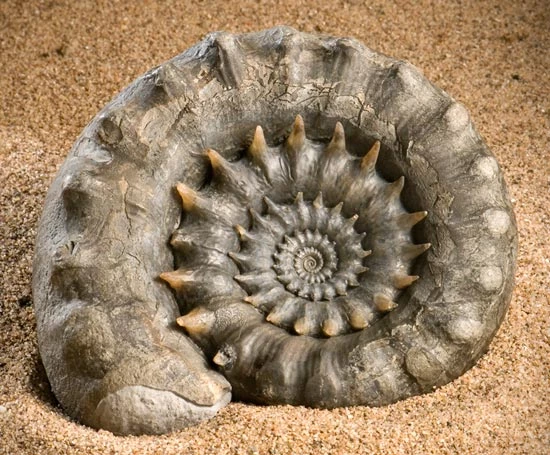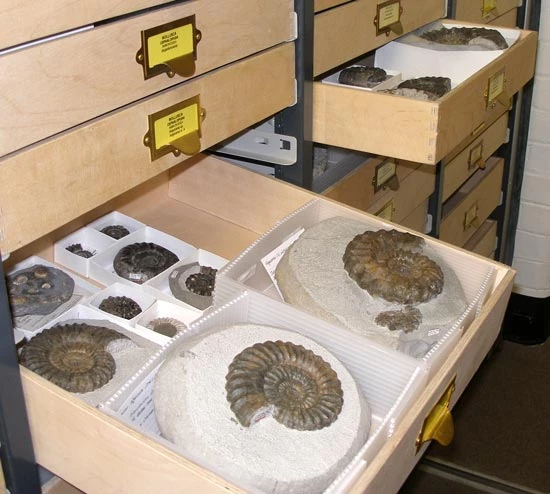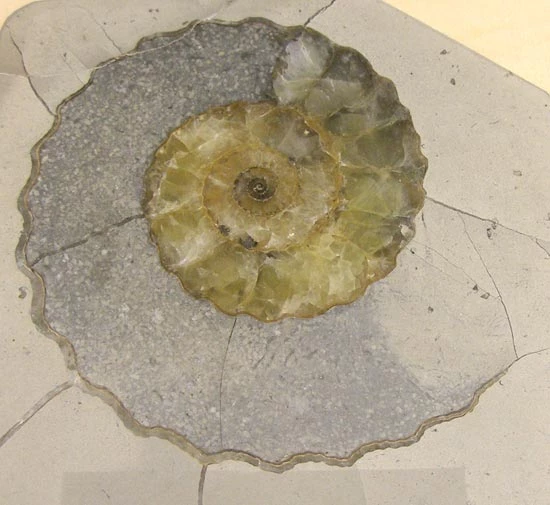Secrets of the ammonites
The specimen after preparation, revealing the delicate spines
Ammonites in the collections at Amgueddfa Cymru
Section through an ammonite showing the chambers
Underside of the prepared specimen
Delicate spines on the inner whorls. Similar spines would originally have been present on the outer part of the ammonite as well, but these had been worn away by erosion
Scientists have managed to dissolve the rock surrounding the fossil of a 190-million-year-old ammonite, revealing, for the first time its intricate pattern of spines.
When you pick up a fossil on a beach it is often broken or eroded. You might discard it because it is poorly preserved or incomplete. But most fossils are found partially concealed in rock, and in these cases they can carry hidden secrets.
One such ammonite fossil had been lying in a drawer in the Geology Department at the Museum for 50 years. It is part of a collection of almost 6,000 fossils donated by James Frederick Jackson in 1960.
James Frederick Jackson
Jackson lived in a small cottage at Charmouth near Lyme Regis, and spent his spare time collecting rocks and fossils around the Dorset coast. From 1914 to 1919 he worked at the Museum, and over his lifetime he donated almost 21,000 specimens.
Palaeontologists regularly consult the Jackson collection because it contains a complete and valuable record of Dorset's Jurassic fossils. A few years ago, one such researcher noticed that a particular ammonite was unusual. However, much of it remained concealed in rock, which needed to be carefully removed by specialists to reveal the fossil.
A year of preparation
After a year of painstaking work, the specimen was finally returned to the Museum to take pride of place in the collections. The limestone sediment had been completely removed with a solution of weak acid and, for the first time, the detail of delicate spines on the inner whorls could be seen. Similar spines would originally have been present on the outer part of the ammonite as well, but these had been worn away by erosion.
The specimen features in a recently published monograph of the Palaeontographical Society, in a series devoted to the scientific description and illustration of British fossils, under the formal scientific name of Eoderoceras obesum (Spath).
Ammonites
Ammonites lived in the Mesozoic Era (251-65.5 million years ago) and were marine animals related to the Nautilus. They swam in the sea, preying on smaller marine animals. They usually had a spiral shell which could be from 5mm to 2m across. Their shells could be smooth, ribbed or knobbly, or even spiny. They lived in the outer whorl of their shell, while the inner part consisted of gas-filled chambers used for buoyancy. You can often see an intricate pattern on the surface of ammonite shells, which marks the division between each chamber. All these features are used by palaeontologists to identify different species of ammonites.
The Museum has large and scientifically important collections of ammonites, mainly from south-west Britain. They are a valuable tool in helping scientists understand the geology and palaeontology of Britain.





Comments - (7)
Many thanks,
Nancye Church
Hi Richard,
I've contacted you with the email address you provided. Would you be able to send me a photo or two of your ammonite and I'll take a look.
Thanks,
Cindy
I have a portion of an ammonite showing the ?inside whorl cavity with spine bases 3/4 of the distance to the outer whorl edge lying upon a gently curved suture line, one appears to branch bifurcate rather like a Harpoceras, however it may be a simple sickle shape as the inside cavity has some sand grains attached in its uncleaned state. It was found within a roadside flint I'm afraid to say, we live near Norwich obviously on the chalk with flints. You may have access to more datasets but I was initially checking against your Wales Museum website.
Any ideas on its name and or age? Photo available.
Thanks Richard.
https://photos.app.goo.gl/aQKGVcdb7au1YEwg9
Hi John,
I’m really sorry but we don’t have any ammonites from Trevor Rocks, or anywhere near there. The rocks in that area are about 350 million years old, and ammonites first appeared about 200 million years ago.
There are a few other coiled shelled animals which are types of nautilus and some of these appear earlier, but I’m not aware of any from here. We do have a set of small trilobites though.
Best wishes,
Cindy